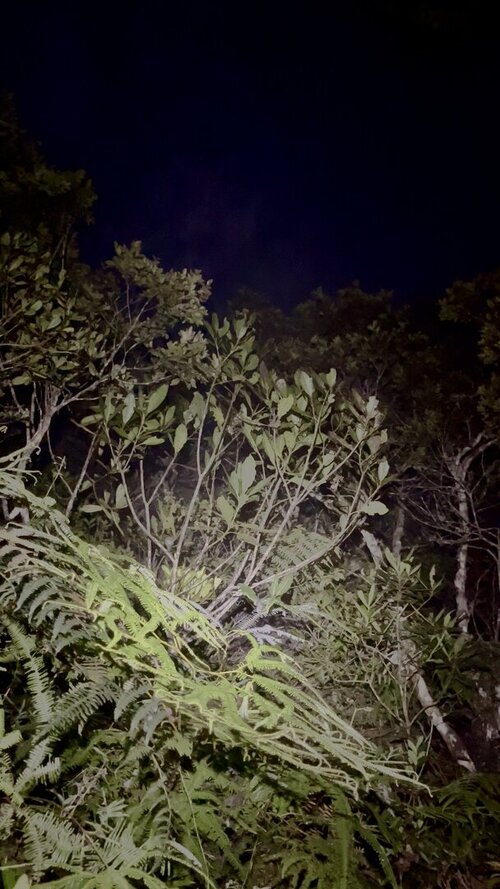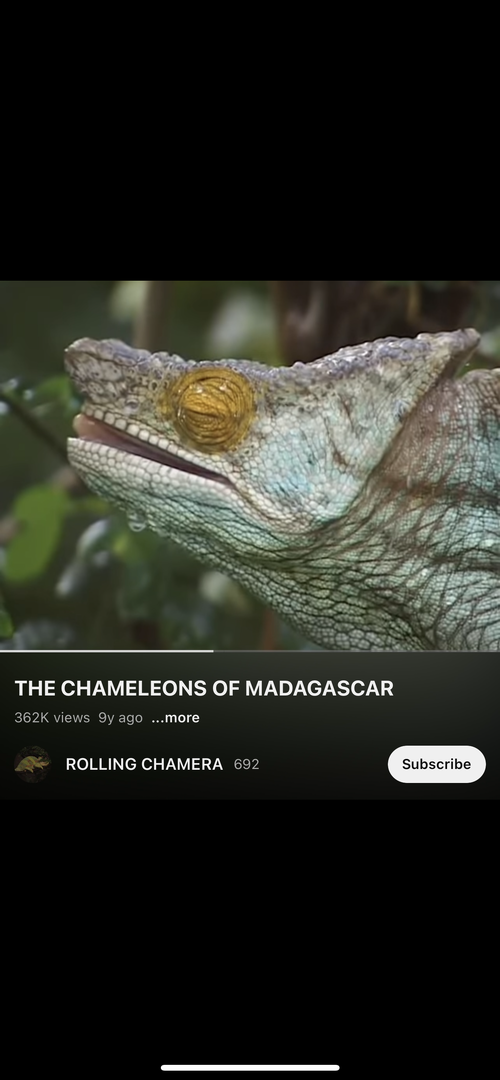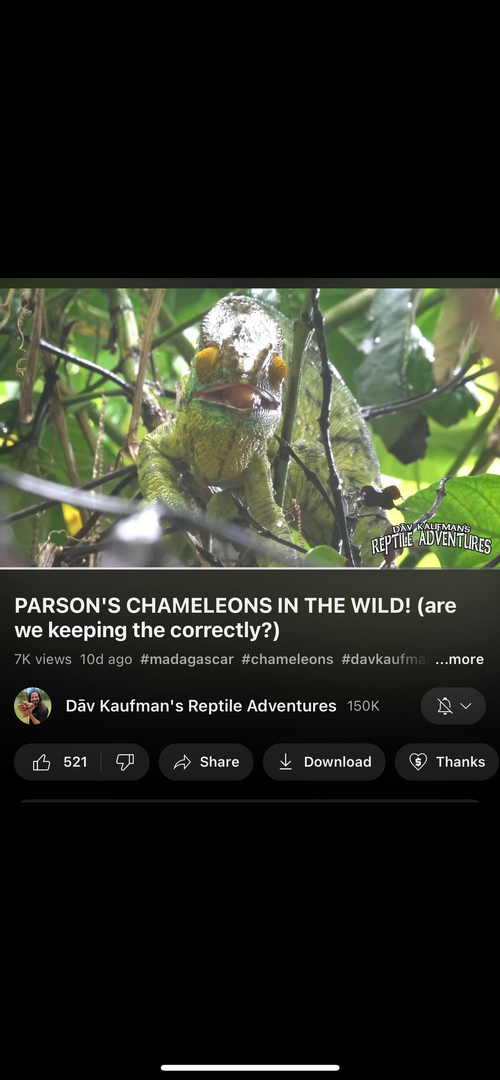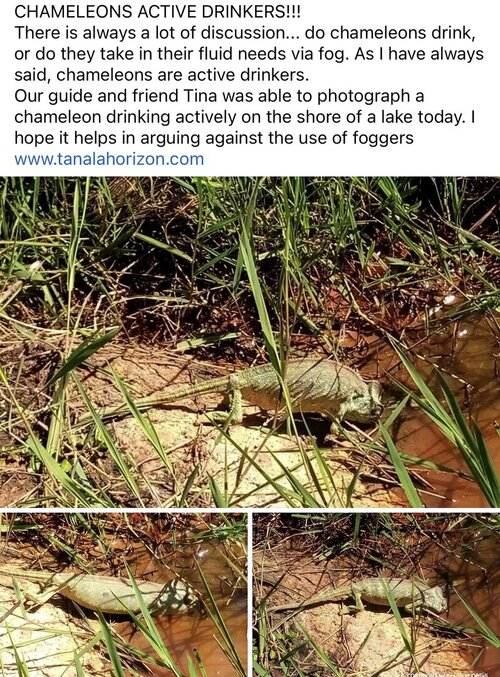javadi
Chameleon Enthusiast
Now for some thoughts about fog, mist, and rain. Just sharing some observations, whether this actually matters and provides a clear path forward to improving chameleon care remains to be seen. Fogging and misting are kind of tense topics that I'm not trying to stir up too bad but I just wanted to put out some thoughts about it based on observations in the wild. My main thought is that maybe the actual droplet size that commercial foggers produce matters, and isn't quite the same as what happens in the wild. Enforcing heterogeneity of droplet size from foggers might resolve some issues present with fog use in captivity.
Although I haven't spent as long in Madagascar as some others, I noticed something rather interesting. Indeed, fog would move in sometimes around andasibe and ranomafana. What I wouldn't have expected is just how wetting this fog was. Interestingly, I could actually see the large droplets of water that made up the fog, and it was especially obvious when putting a light up at night. Putting my hand up in the fog led to it becoming wet very quickly, more akin to what happens with a mister vs. what I have observed for either DIY or commercial fogging systems in captivity. I'd almost rather call the fog I saw "mist". Within a minute or sometimes less, whatever the fog was passing over would become visibly wet. However, the humidity at this time would go up to near 100%, a bit higher than in the daytime but not by a huge margin (5-25%). I didn't stay for the entire night but I did stay for about 6 hours after the fog started rolling in on several occasions, and the observations held steady through that time. Another thing that struck me was the intensity that the fog/mist rolled in with, you could see it approaching on the mountain and it blew in pretty aggressively. This was, however, distinct from rain. It made me think that misting actually does play a part in replicating what happens in the wild, and perhaps blowing fog in at the same time as misting has a role in captive husbandry.
The house of hydro (often used in DIY fogger setups, which I use myself) states that its foggers produce droplet sizes from 3-5um in size, which is close to the range of how fog in the wild seems to start out (4-5um across 6 different fog processes). However, there is a lot of work being done to assess "fog dynamics" wherein collisions between droplets changes their size and properties in real time based on the environment the fog is blowing through and the time it has existed in that state. It's extremely hard to predict how this will happen, but research does indicate that the droplet size of the fog is really dynamic and does not stay homogenous for long. Even the act of fog rolling in probably rapidly changes the droplet size and makes things more heterogenous, with much larger droplets forming along the way.
https://acp.copernicus.org/articles/22/11305/2022/
https://www.mdpi.com/2073-4433/11/3/258#:~:text=The average values of the,, and 16.98 μm, respectively.
I wonder if there is a way to vary the droplet size of foggers, so it has a mix moreso than a homogenous droplet size. In the wild, there appears to be either mostly very large water droplets, or a mix of large + non-visible droplets (can't tell the difference visually), from my (admittedly just a couple weeks of) observations. During the daytime (when it was relatively warm, mid 70 degrees), we would often walk into basically a cloud of fog that was sort of hovering around the forest. This was more akin to the type of fog I've seen from foggers, but the humidity was of course also extremely high. It was hard to distinguish, with basic senses, between being in effectively a cloud of fog vs. being in a high humidity area. Once we were in the cloud it looked pretty similar to a normal high humidity environment. So I wonder if we are able to gauge if we are doing things correct with fog vs. humidity by vision alone, maybe not.
Another thing that may be intuitive but was interesting to observe empirically over there was the fact that rain (where I went at least, all around andasibe region, ranomafana and the road to it (ambositra, ansirabe etc.) does not always happen when humidity is high, and it can be relatively low humidity for the area (60-70% vs. 71-100%) yet still have rain fall. In fact, some of the only times I saw humidity below 70% on the whole trip was when rain was falling. So rainfall itself does not instantly raise the humidity, it takes time. Again, this has been previously observed, but I think worth commenting on. During rainfalls I did observe C. Osh (oshaughnessyei) males and females moving around in low trees and shrubs, as well as plenty of parsonii and other species. They were also active during morning fog and/or mist. During heavy rainstorms at night, I surprisingly found F. balteatus, F. bifidus, C. tijiasmantoi, C. brevicorne, and others (including babies!) sleeping just slightly sheltered, largely in the open, getting pelted by rain and mist. So their exposure to the elements might be more in the wild than we allow in captivity, but that's probably not a novel observation.
However, this high exposure to the elements contradicts with cases I and others have observed where blasting chameleons, especially babies, with extremely thick and aggressive fog streams, even intermittently, can lead to very quick respiratory distress and often infection. And this was done at temps under 62 degrees and with lots of airflow, so it is not just an issue of high temps or some other unrelated issue. I wouldn't expect this given what they seem to deal with and thrive in in the wild. When awake, they don't seem to respond well to getting suddenly blasted by mist, but it doesn't instantly give them signs of respiratory distress, whereas fog from commercial foggers has in some cases. So that leads me to believe that the actual quality of the fog and potentially the droplet size we are using isn't fully replicating what happens in the wild. Otherwise I would expect even excessive fog would not be a problem, since they experience severe fog/mist/rain in the wild as similar intensities. It would be very interesting to experiment with a device that varies the droplet sizes of the fog to see if that improves hydration. Water droplets travel further into the respiratory tract as they get smaller. It's not outlandish to imagine a situation wherein very tiny droplets kind of saturate one area of the chameleon lung inappropriately due to unnaturally and homogeneously small small droplet size. This is of course, speculation.
For what it's worth, I fog a lot for larger chameleon species (C. osh, C. parsonii cristifer) with success. But for the little ones it hasn't been as useful. So I'm not advocating for not fogging, just that we examine this closely. Perhaps larger species are just able to deal with a margin of error from commercial setups easier than smaller ones, and thus reap more of the benefits of hydrating through fog in captivity.



Above: Progression of "aggressive" fog/mist in Maromizaha over 30 minutes or so.
Above: Video of fog/mist rolling in very aggressively

(Above, C. Tijiasmantoi courting a female during the rain, with wet leaves).

Above: Daytime fog in Ranomafana.

Above: Female c. osh active and possibly foraging during rain storm midday in Ranomafana. See the water droplets on her?

Above: An active male C. osh found on the adjacent vine during a mild rainstorm
Although I haven't spent as long in Madagascar as some others, I noticed something rather interesting. Indeed, fog would move in sometimes around andasibe and ranomafana. What I wouldn't have expected is just how wetting this fog was. Interestingly, I could actually see the large droplets of water that made up the fog, and it was especially obvious when putting a light up at night. Putting my hand up in the fog led to it becoming wet very quickly, more akin to what happens with a mister vs. what I have observed for either DIY or commercial fogging systems in captivity. I'd almost rather call the fog I saw "mist". Within a minute or sometimes less, whatever the fog was passing over would become visibly wet. However, the humidity at this time would go up to near 100%, a bit higher than in the daytime but not by a huge margin (5-25%). I didn't stay for the entire night but I did stay for about 6 hours after the fog started rolling in on several occasions, and the observations held steady through that time. Another thing that struck me was the intensity that the fog/mist rolled in with, you could see it approaching on the mountain and it blew in pretty aggressively. This was, however, distinct from rain. It made me think that misting actually does play a part in replicating what happens in the wild, and perhaps blowing fog in at the same time as misting has a role in captive husbandry.
The house of hydro (often used in DIY fogger setups, which I use myself) states that its foggers produce droplet sizes from 3-5um in size, which is close to the range of how fog in the wild seems to start out (4-5um across 6 different fog processes). However, there is a lot of work being done to assess "fog dynamics" wherein collisions between droplets changes their size and properties in real time based on the environment the fog is blowing through and the time it has existed in that state. It's extremely hard to predict how this will happen, but research does indicate that the droplet size of the fog is really dynamic and does not stay homogenous for long. Even the act of fog rolling in probably rapidly changes the droplet size and makes things more heterogenous, with much larger droplets forming along the way.
https://acp.copernicus.org/articles/22/11305/2022/
https://www.mdpi.com/2073-4433/11/3/258#:~:text=The average values of the,, and 16.98 μm, respectively.
I wonder if there is a way to vary the droplet size of foggers, so it has a mix moreso than a homogenous droplet size. In the wild, there appears to be either mostly very large water droplets, or a mix of large + non-visible droplets (can't tell the difference visually), from my (admittedly just a couple weeks of) observations. During the daytime (when it was relatively warm, mid 70 degrees), we would often walk into basically a cloud of fog that was sort of hovering around the forest. This was more akin to the type of fog I've seen from foggers, but the humidity was of course also extremely high. It was hard to distinguish, with basic senses, between being in effectively a cloud of fog vs. being in a high humidity area. Once we were in the cloud it looked pretty similar to a normal high humidity environment. So I wonder if we are able to gauge if we are doing things correct with fog vs. humidity by vision alone, maybe not.
Another thing that may be intuitive but was interesting to observe empirically over there was the fact that rain (where I went at least, all around andasibe region, ranomafana and the road to it (ambositra, ansirabe etc.) does not always happen when humidity is high, and it can be relatively low humidity for the area (60-70% vs. 71-100%) yet still have rain fall. In fact, some of the only times I saw humidity below 70% on the whole trip was when rain was falling. So rainfall itself does not instantly raise the humidity, it takes time. Again, this has been previously observed, but I think worth commenting on. During rainfalls I did observe C. Osh (oshaughnessyei) males and females moving around in low trees and shrubs, as well as plenty of parsonii and other species. They were also active during morning fog and/or mist. During heavy rainstorms at night, I surprisingly found F. balteatus, F. bifidus, C. tijiasmantoi, C. brevicorne, and others (including babies!) sleeping just slightly sheltered, largely in the open, getting pelted by rain and mist. So their exposure to the elements might be more in the wild than we allow in captivity, but that's probably not a novel observation.
However, this high exposure to the elements contradicts with cases I and others have observed where blasting chameleons, especially babies, with extremely thick and aggressive fog streams, even intermittently, can lead to very quick respiratory distress and often infection. And this was done at temps under 62 degrees and with lots of airflow, so it is not just an issue of high temps or some other unrelated issue. I wouldn't expect this given what they seem to deal with and thrive in in the wild. When awake, they don't seem to respond well to getting suddenly blasted by mist, but it doesn't instantly give them signs of respiratory distress, whereas fog from commercial foggers has in some cases. So that leads me to believe that the actual quality of the fog and potentially the droplet size we are using isn't fully replicating what happens in the wild. Otherwise I would expect even excessive fog would not be a problem, since they experience severe fog/mist/rain in the wild as similar intensities. It would be very interesting to experiment with a device that varies the droplet sizes of the fog to see if that improves hydration. Water droplets travel further into the respiratory tract as they get smaller. It's not outlandish to imagine a situation wherein very tiny droplets kind of saturate one area of the chameleon lung inappropriately due to unnaturally and homogeneously small small droplet size. This is of course, speculation.
For what it's worth, I fog a lot for larger chameleon species (C. osh, C. parsonii cristifer) with success. But for the little ones it hasn't been as useful. So I'm not advocating for not fogging, just that we examine this closely. Perhaps larger species are just able to deal with a margin of error from commercial setups easier than smaller ones, and thus reap more of the benefits of hydrating through fog in captivity.
Above: Progression of "aggressive" fog/mist in Maromizaha over 30 minutes or so.
Above: Video of fog/mist rolling in very aggressively
(Above, C. Tijiasmantoi courting a female during the rain, with wet leaves).
Above: Daytime fog in Ranomafana.
Above: Female c. osh active and possibly foraging during rain storm midday in Ranomafana. See the water droplets on her?
Above: An active male C. osh found on the adjacent vine during a mild rainstorm
Attachments
Last edited:










